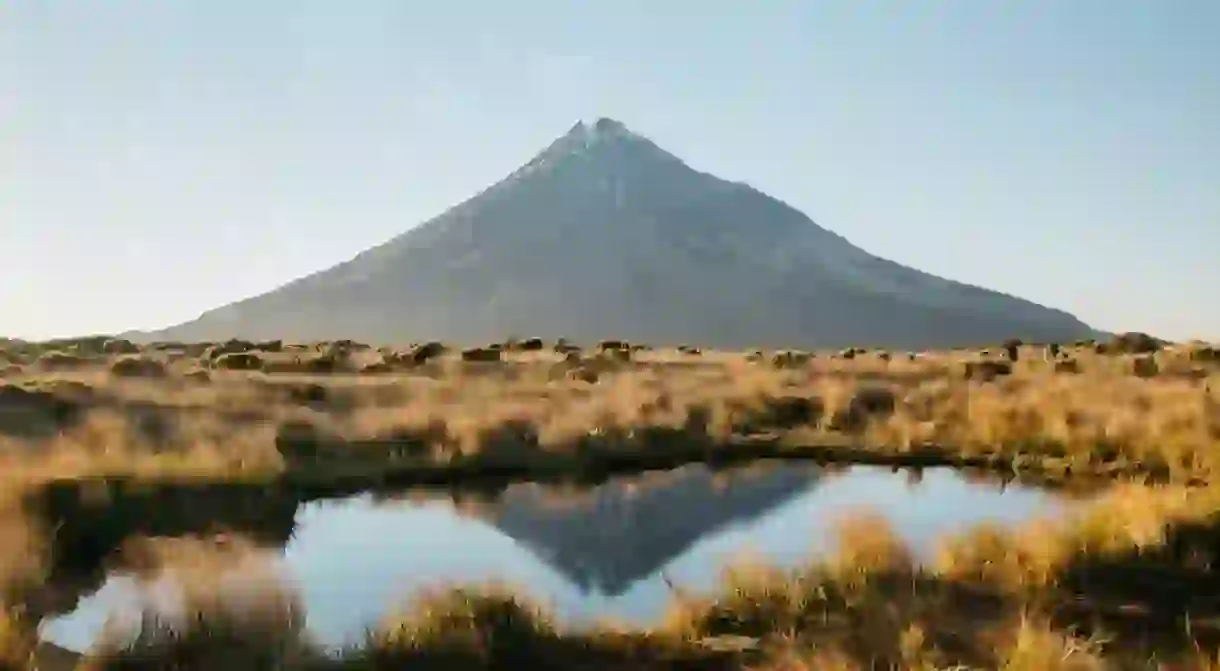A Guide To Trekking Egmont National Park, New Zealand

Set on the western coast of New Zealand’s North Island, Egmont National Park is surrounded by verdant forests, sparkling waterfalls and the ever-majestic Mt Taranaki.
This a place that offers many hiking opportunities. More experienced trekkers, for instance, could tackle the 4–5 day Around the Mountain Circuit — which is best enjoyed during the warmer months, from October to April.

The national park is composed of a series of marked tracks and river crossings. There’s even a trail that was designed with wheelchair friendliness in mind.

Naturally with so many mountains around, there are lots of ascending and descending sections to keep the trek interesting.

A mixture of high rainfall and mild coastal climates are to thank for the lush rainforests that rise up the altitudes.

Keep your eyes peeled — there are native birds all around. The tui, for instance, is commonly found feeding on flax nectar and can be easily recognised thanks to its unusual bird call.

Mighty waterfalls also abound. Depending on which track you take, you’ll be able to catch a glimpse of the Dawson Falls (home to one the world’s oldest operating generators), the Curtis Falls (with shallow pools that are perfect for a summertime dip) and the Mangakotukutuku Falls (particularly renowned for its ancient archaeological features).

Don’t forget to spend some time delving into the area’s colourful past. If you take a short, 10-minute detour from the Egmont National Park Visitor Centre towards the boardwalk that meanders past the historic Camphouse, you’ll come across the Ambury Memorial. This monument was erected in memory of Arthur Ambury, a climber who put his own life at risk to rescue William Edwin Gourlay as he slipped on ice. Neither of them made it back alive.

But back to more cheerful matters now. Even on an overcast day, the greenery is sure to bewilder.

It’s interesting to note that Egmont National Park’s vegetation is incredibly complex: the trees, flowers and shrubs on lower areas aren’t found in higher altitudes.

Smaller plants in particular tend to be found amid the coastal lowlands.

Besides hiking, many people head to this park to conquer Mt Taranaki’s summit.

This is an adventure best suited for the summer months (December to April) and calls for a sound fitness level.

Just so you know, it can take up to six hours to walk up the mountain and four hours to come down.

And in winter or spring conditions, you might need to pack some alpine equipment with you — hence the reason summer is the optimal time to hike there.

Thick cloud is another issue to take into account — if it’s too foggy to navigate, it’s safer to turn back around.

All safety warnings aside, the journey is fantastic.

A blanket of native trees can be seen in all directions. There are some exotic species around too, but these are slowly being phased out to help the natural flora flourish and grow.

And what can we say about the exquisite waterfalls? They’re a great place for a quick breather before you hit the walking tracks once more.

And the soft rumbling as the cascades roll down is guaranteed to lift up anyone’s spirits.


With a height of 2518 metres (8261 feet), Mt Taranaki (aka Mt Egmont) is believed to be one of the most symmetrical volcanic cones in the world.

Its height is as treacherous as it is impressive — more than 80 climbers have lost their lives along these slopes. Not that this should discourage anyone from visiting: it’s just a friendly reminder that you need to be prepared.

The mountain gets its English name (Egmont) from John Perceval, the second Earl of Egmont. A former First Lord of Admiralty of the Royal British Navy, the Earl of Egmont endorsed Captain James Cook’s first expedition to the South Pacific — as such, Cook named the mountain in his honour.

As for its Māori name, legend tells us that Taranaki was ousted from the North Island’s Central Plateau (where Tongariro National Park is situated) after he made romantic advances on a beautiful mountain named Pihanga.

Whether you call it Taranaki or Egmont (both names are interchangeable), the mountain is famously known as New Zealand’s ‘most climbed’ — even non-mountaineers can manage its steepness. If you prefer to observe from a faraway distance, though, the Pouakai Crossing offers the perfect vantage point for it.

Egmont National Park is actually one of the most accessible of New Zealand’s national parks as well. It has three road entry points and is within close range to towns like New Plymouth, Inglewood, Stratford and Opunake.

If you don’t want to base yourself in the nearby towns, the Department of Conservation has eight cabins available for trekkers. There are private lodges within the park too.

Wherever you stay and whatever walking route you take, you can expect to come face to face with some of the remarkable landscapes that make New Zealand so loved by adventurers and nature enthusiasts.














